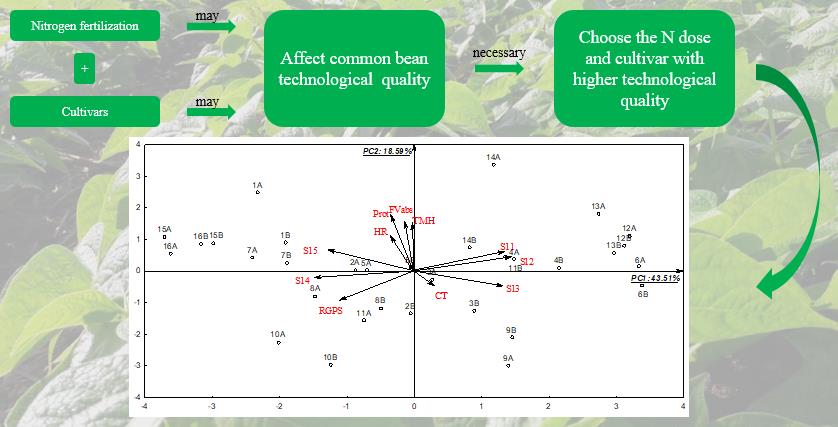Grain quality of common bean cultivars under low and high nitrogen dose
DOI:
https://doi.org/10.48162/rev.39.012Keywords:
nitrogen fertilization, genotypes, grain technology, cooking time, protein contentAbstract

This study aimed to evaluate the effects of low and high topdressing doses of nitrogen (N) on the qualitative attributes of common beans (Phaseolus vulgaris L.) cultivars and indicate cultivars with better grain technological characteristics. The experimental design was randomized blocks in split plots, with four replicates. Plots comprised 16 common bean cultivars of the commercial grain ‘Carioca’, while subplots comprised two N doses: 20 and 120 kg ha-1 applied as topdressing. The following evaluations were carried out: sieve yield (SY), relative grain production on sieves (RGPS), crude protein content (PROT), final water volume absorbed (FVabs), time for maximum hydration (TMH), hydration ratio (HR), cooking time (CT) and resistance to cooking (RC). The results were subjected to analysis of variance by F test and means were grouped by the Scott-Knott test. Multivariate principal component analysis was used to identify processes. The grain quality of common bean is more dependent on the genotype studied than on agricultural management such as nitrogen fertilization. The increase in the N dose applied as topdressing increases the size of common bean grains and their protein content, but with little influence in grain hydration. FVabs and CT depend on the interaction between cultivar and N doses. CT had an inverse correlation with PROT, but it was little pronounced. The cultivars BRSMG Uai, IAC Alvorada, TAA Dama and TAA Bola Cheia have the best grain quality characteristics.
Highlights:
- Cultivar interferes more in the common bean technological quality than nitrogen fertilization.
- Grains crude protein content had an inverse correlation with the cooking time.
- Nitrogen fertilization increases the grains size and crude protein content of common bean, but with little influence in grain hydration.
- The cultivars BRSMG Uai, IAC Alvorada, TAA Dama and TAA Bola Cheia have the best grain quality characteristics.
Downloads

Downloads
Published
How to Cite
Issue
Section
License
Copyright (c) 2018 Revista de la Facultad de Ciencias Agrarias UNCuyo

This work is licensed under a Creative Commons Attribution-NonCommercial-ShareAlike 3.0 Unported License.
Aquellos autores/as que tengan publicaciones con esta revista, aceptan las Políticas Editoriales.










.jpg)




